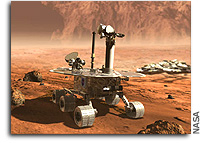“Marsoweb,” an interactive Web site developed by NASA, is helping scientists select suitable landing sites for future missions to Mars.
 Scientists preparing for NASA’s next Mars mission, the twin Mars Exploration Rovers scheduled for launch in June and July 2003, are able to view more than 44,000 high-resolution images of Mars collected by the Mars Global Surveyor. Some show detail at less than three meters per pixel. These images are registered with context images and maps of thermal properties, rock abundance, slope roughness and geology acquired by the Viking and Global Surveyor orbiters and with altimeter and mineralogical data returned by Global Surveyor, which is still operating at Mars. The Web site provides scientists with special software tools to facilitate their interpretation of the data.
Scientists preparing for NASA’s next Mars mission, the twin Mars Exploration Rovers scheduled for launch in June and July 2003, are able to view more than 44,000 high-resolution images of Mars collected by the Mars Global Surveyor. Some show detail at less than three meters per pixel. These images are registered with context images and maps of thermal properties, rock abundance, slope roughness and geology acquired by the Viking and Global Surveyor orbiters and with altimeter and mineralogical data returned by Global Surveyor, which is still operating at Mars. The Web site provides scientists with special software tools to facilitate their interpretation of the data.
“The Center for Mars Exploration (CMEX), in collaboration with the NASA Advanced Supercomputing (NAS) Division at NASA Ames, created this Web site to make sure that future Mars lander projects can benefit fully from all the available remote-sensing data to allow them to select the best landing sites – namely, those that combine scientific appeal and mission safety,” explained Dr. Geoffrey Briggs, scientific director of CMEX, located at NASA Ames Research Center, in California’s Silicon Valley.
Ames’ CMEX planetary geologist and project lead Dr. Virginia Gulick of the SETI Institute and Glenn Deardorff, a visualization technologist in the NAS Division at NASA Ames who has an undergraduate degree in geophysics, developed Marsoweb over the past three years to make a significant contribution to the ongoing Mars exploration program.
“It is easy to be overwhelmed by the great variety of available data relating to a candidate landing site,” said Gulick, who serves on a NASA committee guiding the landing site selection process. “By pulling everything together and adding advanced visualization and analysis tools, we’ve enabled people to focus on studying the candidate sites and not lose time worrying about how to display, manipulate and compare all the relevant, but disparate, data sets,” she said.
“More than 100 sites on Mars have been considered by dozens of planetary scientists who are involved in analyzing candidate landing sites,” said Deardorff. “Marsoweb provides a resource for them to increase their productivity as they wade through the available data.”
The goal of the Mars Exploration Rover mission is to learn more about Mars’ geologic and climate history, both of which are closely tied to the history of water on the red planet and to the possibility that life may have evolved there. Scientists are using orbital data to help them select landing sites of geological interest — where water was once available and the past environment may have been conducive for life. Orbital images reveal many regions that evidently have been shaped by water and the Thermal Emission Spectrometer on Global Surveyor has identified a region where the mineral hematite, an iron oxide sometimes formed in the presence of water, is abundant. Mars provides a wealth of exciting landing sites, but most of them present surface hazards to the current generation of landers.
“The main goal of Marsoweb has been to provide online analysis and visualization tools so the science community can interpret the highest resolution images in their regional context and with the benefit of the other remote-sensing information that is available,” Gulick said. “We rely on those images to identify sites of highest science interest and we need data at multiple resolutions, as well as other data to identify sites that are relatively free of hazards,” she said. “Providing the information in a user-friendly format is essential.”
Marsoweb includes an interactive feature developed by Deardorff that allows scientists to view Mars’ surface in perspective and from any angle to help assess prospective landing sites from a collection of more than 400 images. This Marsoweb software feature contains a Virtual Reality Modeling Language (VRML) component that provides a 3-D image of the surface of Mars. Using the VRML, users can enjoy zooming through the canyons and valleys of Mars or over its volcanoes and desert dunes. Another time-saving feature of the Web site allows scientists to rapidly superimpose high-precision elevation data from the Mars Orbiter Laser Altimeter (MOLA) on images of the surface.
In addition to its use by the science community, Deardorff said Marsoweb also has proven popular with the general public. “It’s also becoming an effective public outreach vehicle for people wanting to know more about Mars,” he said. “Since its inception in August 1999, Marsoweb has been viewed by more than 44,000 distinct users, resulting in more than 1,880,000 ‘hits,'” he added.
Deardorff and Gulick said they are continuously updating and improving the Web site. They welcome suggestions for improvement from both the science community and the general public. In addition to integrating data from Global Surveyor, they also are planning to add Mars Odyssey data as they become available. Mars Odyssey is the other spacecraft currently in orbit around Mars and carries its own suite of unique remote-sensing instruments. Each mission incorporates new remote-sensing instruments that introduce new challenges for scientists to understand and to compare with what they already know about Mars, based on data taken from previous missions. Gulick said a goal of the Marsoweb effort is to remove the barriers that such new remote-sensing instruments typically impose on comparing data sets and allow the focus to be on science. In addition to incorporating all the latest spacecraft data, they also have plans to create an electronic notebook to enable scientists to collaborate with each other, store images, annotations and other data.
Deardorff said developing the Marsoweb is the culmination of a childhood dream. “Being able to develop a virtual presence of another planet has been the most satisfying part of the whole process,” Deardorff said. “It’s like projecting the eyes and ears of humans into another world.”
The Marsoweb project is a joint collaboration between the NASA Ames Center for Mars Exploration, the NAS Exploratory Computing Environments Group at NASA Ames and the Mars Exploration Program Office at NASA’s Jet Propulsion Laboratory, Pasadena, Calif. The project is funded by NASA’s Office of Space Science through its Mars Data Analysis Program and through NASA Ames’ Applied Information Systems Research Program.
For more information about Marsoweb, see the project Web site located at:
To view publication size images, please refer to the link below:
http://www.amesnews.arc.nasa.gov/releases/2002/02images/marsexp/marsexp.html









